Well or well - which is better? Detailed comparative review
The desire to acquire their own source of water for many owners of suburban areas is quite logical and natural. The only stumbling block in resolving this issue is determining what is still better - a well or a well?
Builders who perform well digging services are ready to give a sea of arguments, confirming that the well is a brilliant invention that will function properly for five decades. Masters who specialize in well drilling convince us that a well is the best option for a hydraulic structure.
Each of these two methods of water production has its pros and cons, the main of which we will consider in this article. Why do we compare the complexity and cost of constructing each of these options for water intake, compare the service life and frequency of preventive cleaning.
And also talk about the quality and volume of produced water. All these factors will help you determine the best way to extract water, the most suitable for your living conditions and which can satisfy all your needs.
The content of the article:
Design features of a well and a well
The well is a hydraulic structure in the form of a vertically dug cavity with a depth of 30 meters and a shaft diameter of over 70 centimeters, the walls of which are reinforced reinforced concrete rings.
In the soil layers, several aquifers occur at different depths. Upper - referred to as the tip, is located 2-3 meters from the surface. Its water is quite muddy and dirty, because it feeds on drainage and storm drains that penetrate through the soil and technogenic deposits.
The water produced from this layer is used to water plants. A little deeper in the sandy aquifers lies groundwater.They also extract water from the arrangement of the drinking well.
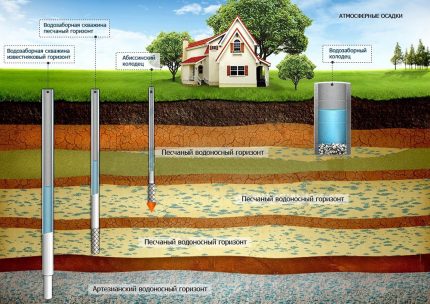
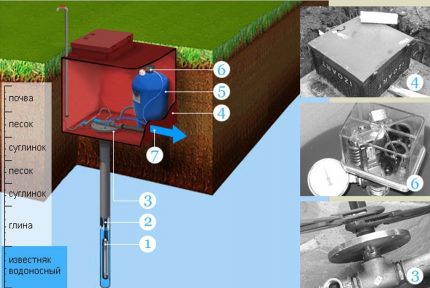
There can be several aquifers in the earth, and they alternate with water-resistant layers. To extract water from the first and second sandy horizons abyssinian wells - wells of small diameter, which during installation do not drill, but pierce the soil layers with an inch rod, like a needle.
At a depth of 200 meters and below are limestone layers, referred to as artesian. They contain large reserves of water than the same sand formations.
The key difference of an artesian well is that it produces water that lies between two dense layers.
Since the price of such a hydraulic structure directly depends on the depth of the structure, and its productivity is ten times higher than the needs of one family, artesian wells are most often installed collectively: one on the street or on the whole village.

Comparative water withdrawal cost
For many owners, the question of choosing which is better is a well or a well, far from idle. After all, it is he who determines the cost of the construction and maintenance of the water production facility.
When calculating the estimated estimated cost of water intake, a number of parameters should be taken into account:
- earthwork per each linear meter in depth;
- volume of materials to strengthen the walls of the penetration;
- frequency of maintenance of the facility.
As calculations show, at the cost of costs, including all installation work and maintenance of the erected structure, a well is cheaper.
Due to the low cost of excavation, which can be done without the involvement of heavy machinery, many summer residents, gardeners and villagers can afford to install a well.

The estimated cost of completing the well varies from 30 to 40 thousand rubles.
It includes:
- Installation of a bottom filter (4-5 thousand rubles).
- Filtration gravel dumping (1-1.5 thousand rubles).
- Outdoor house for the head (from 7 thousand rubles).
- Submersible pump with installation (15 + 7 = 22 thousand rubles).
Well construction without taking into account the laying of communications from the water intake point to the consumption points will cost about 100 thousand rubles. The cost depends on the season, the depth of drilling and the equipment used. In more detail, the main factors affecting the final cost of the well construction, we examined in this article.

The price of a pump for a mine well also comes out an order of magnitude cheaper compared to pumping equipmentnecessary when arranging a well.
Preventative Cleaning Frequency
Preventive well maintenance activities spend annually. The price of such an annual sanitary treatment carried out by the efforts of masters specializing in this field is about 6 thousand rubles.

When conducting a thorough cleaning of the walls from siltation, which is carried out once every five years, you will have to spend another 7 thousand rubles. If it is necessary to replace the bottom filter, the cost of work doubles.
And here well flushing in this regard is cheaper. With proper well construction, maintenance of a hydraulic structure is reduced only to monitoring the operation of the system, since it does not need to be cleaned annually.
Preventive cleaning of the system is performed every five years. The cost of the service, depending on the depth of the structure, varies from 6 to 50 thousand rubles.
Water purification from the well is carried out by installing filters. It is easy to take care of the filtering elements of the structure: they only need to be cleaned and changed as necessary.
Features of installation of structures
In construction technologies and requirements for the placement of mine and tubular wells, there are also a number of significant differences that affect the choice of the type of water source for arranging suburban estates.
Placement Requirements
When arranging a well, it is important to maintain a distance from buried septic tanks, sewers and surface pollutants. Taking into account the current sanitary standards, it should be at least 50 meters to cesspools, toilets and stockyards located on the septic tank.
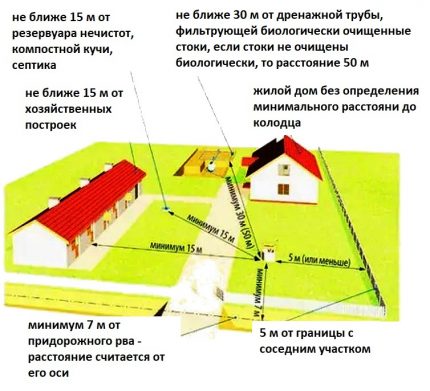
Choosing a place for drilling a sand well, this distance can be reduced to 30 meters without worrying that surface water contaminated with domestic wastewater will reach the water intake point.
The closed design, the walls of which are made of durable moisture-resistant concrete rings, prevents the penetration of contaminated water and debris into its cavity. We talked more about the design of water supply wells on the site in this material.
The requirements for arranging an artesian well are more stringent. Industrial enterprises and other sources of chemical contamination should be removed to a distance of more than 300 meters from the location of the well.
The distance to garbage dumps, burial grounds and centralized sewage systems should be at least 200 meters. Houses and farm buildings and must be removed at least 30 meters.
Obtaining permission and terms of construction
When arranging a well from the first aquifer to the depth of the aeration zone, which is 20 meters, no permits are required. You can determine the horizon of the aquifer experimentally, or by applying for the issuance of geological information of your area in the territorial fund.
When planning to drill a well for the extraction of deep waters, the horizon of which exceeds 20 meters, it is necessary to obtain a package of permits before starting work.
To obtain the right to drill an artesian well and use the water extracted from the bowels of the earth, a project is developed that describes:
- what rocks the well crosses;
- at what depth are the filters;
- whether pipe cementation is provided and to what depth.
The license is issued only for wells intended for the selection of artesian water. Together with the license, the owner of the well receives an agreement, thereby committing himself to submit statistics to the statistics and pay taxes to the tax authorities.
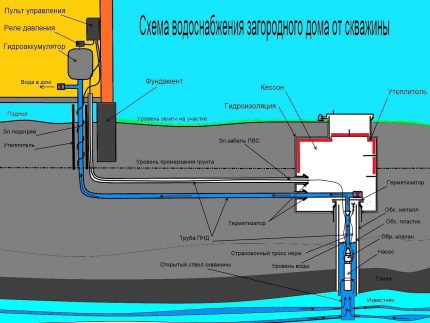
In the passport attached to the documents for the well, all the necessary characteristics will be displayed:
- coordinates of the location of the well;
- immersion depth;
- dynamic and piezometric levels;
- dimensions of casing used;
- construction performance.
The process of drilling a well will take less time than carrying out procedures to coordinate the project in various instances. It takes on average one to two days to equip a sand well and a hydraulic structure like a needle. Read more about well drilling methods and their features.
Drilling an Abyssinian well can also be done on its own, using a manual method using auger drill with a diameter of 150 mm.
For drilling an artesian well, it is better to attract professionals by concluding a contract with them for work. Indeed, any deviation of the barrel from the vertical during the installation process may result in the need to redo the work again.
When installing the well, there is no need to issue construction permits. According to article 19 of the "Law on Subsoil", underground structures are allowed to build underground structures not more than 5 meters deep.
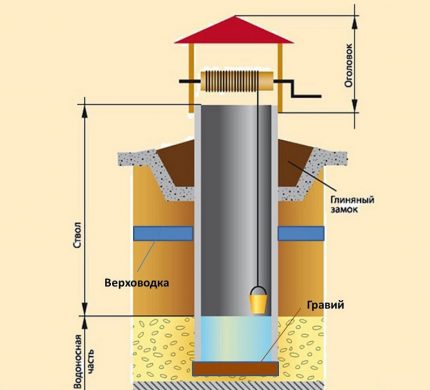
Complexity well construction consists mainly in the laborious process of the mine - it has a large number of structural parts. So, when erecting the walls of a concrete trunk of a structure 30 meters deep, 33 reinforced concrete rings will be required, with a product height of 90 centimeters, and the same number of joints for their connection.
For comparison: with the arrangement of wells use pipes, the length of the segments of which is 2.06 meters. Consequently, they also have fewer joints.
The only thing - after the construction of the well, it is advisable to officially register the material object by entering it into the site plan. BTI imposes no sanctions on the unauthorized construction of a well. The technical plan of the site is the only official document on which the well will be marked.
Operational period of facilities
The life of the well is from 30 to 50 years.
Stable operation of downhole hydraulic structures is on average:
- “Abyssinian needle” - from 5 to 7 years;
- sand well - up to 15 years;
- artesian for over 50 years.
The life of both types of hydraulic structures depends on the quality of the system, the regularity of maintenance, the soil structure of the area and the chemical composition of the produced water.

Volume and quality of produced water
A significant parameter when choosing between a well and a well is also the maximum amount of water "produced" from the source. Some mistakenly believe that the water in the well is much less than in the well, arguing that the well has a much larger cross section than the same well. This is actually not the case.
Features of water intake from the well
Due to the fact that the well is filled only with the waters of the Quaternary sediments, the magnitude of the inflows of the hydraulic structure is limited to up to 0.5 cubic meters / hour. To service a small plot with a house of this volume is enough.
But when arranging a large area plot, including the costs of watering green spaces, filling the pool and other household needs, this amount will be clearly small. And, as practice shows, the volume of water in a well is restored very slowly, in some cases up to several hours.
If we focus on water quality, then the well wins in this regard. When arranging a well, it is impossible to ensure complete waterproofing of the structure, since it is necessary to create conditions for natural flow through the bottom.
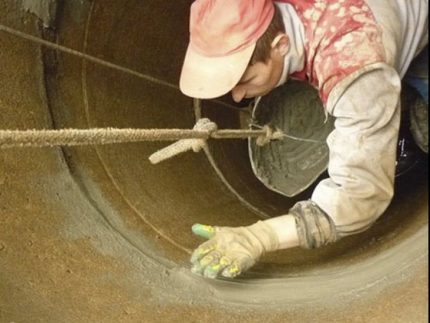
Although the water produced by the well will not have a taste of “rust” and chlorine, it will most likely contain impurities of groundwater after heavy rain or high water. About cleaning water from a well we wrote here.
The specifics of water intake from the well
Spring water has always been considered the cleanest and most useful. Due to the fact that the well draws drinking water at a great depth, it does not mix with horse melt and flood waters. And even after heavy rains, the water produced from the well does not become cloudy. Water in the well is quickly replenished.
The magnitude of the inflows for downhole hydraulic structures is on average:
- "needle" - 0.5 cubic meters per hour;
- sand well - 1.5 cubic meters / hour;
- artesian - 5 cubic meters / hour.
A high inflow is characteristic only of aquifers located as deep as possible from the surface. The stock of the aquifer is practically inexhaustible. Complete drying of the well is not possible even with regular operation of the structure using a powerful pump.

It is worth noting that some well owners complain that the water produced in this way has a slightly metallic taste. But this effect is observed when pipes made of low-quality metal were used during the installation of the structure.
The well selection priority is easily explained by the high tightness of the structure, which is achieved due to the tight fit of the casing to the body of the structure. This prevents the mixing of groundwater and the aquifer.
In addition, borehole type intakes are equipped with reliable filtration systems, due to which a high degree of water purification is achieved. We talked more about water treatment from the well in our other article.
Insects and small amphibians, which during the process of decay can release toxic substances, can contribute to the multiplication of pathogenic microorganisms through a narrow throat closed with a throat.
Conclusions and useful video on the topic
Tips builders on choosing the best source of water:
Summing up, it is worth noting that it is better to equip a mine well in summer cottages intended for seasonal residence, provided that the water is located only a few meters from the ground level. With a small flow of water, which is mainly spent on household needs and watering plants, excess moisture will accumulate in the mine.
In addition, equipping a well in the country, you will always have the opportunity to raise water from a depth manually, which is so important in conditions of frequent power outages.
When arranging areas intended for year-round use, the depth of the water on which is sufficiently large, it is worthwhile to still prefer well drilling. It will have to be spent on its arrangement at first, but in the process of continuous operation of the structure, the cost fully pays.
Do you have any questions after reading our article or can you not decide on the optimal method of water intake for you? Ask your questions, describe your situation in detail in the comment block below - our experts and other visitors to the site will try to help you.

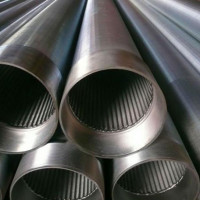 Which pipes are best for the well: an overview and comparison of all types of suitable pipes
Which pipes are best for the well: an overview and comparison of all types of suitable pipes 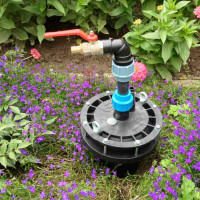 Do-it-yourself well in the country: a review of technology and tools for manual drilling
Do-it-yourself well in the country: a review of technology and tools for manual drilling  Do-it-yourself well without equipment: how to independently arrange a water source
Do-it-yourself well without equipment: how to independently arrange a water source 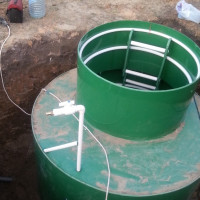 Caisson for a well: what is it, types, purpose, comparative review of structures and installation rules
Caisson for a well: what is it, types, purpose, comparative review of structures and installation rules 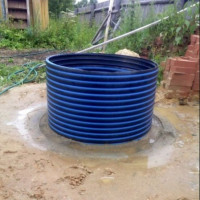 Plastic insert in the well: step-by-step installation instructions
Plastic insert in the well: step-by-step installation instructions  How much does it cost to connect gas to a private house: the price of organizing gas supply
How much does it cost to connect gas to a private house: the price of organizing gas supply  The best washing machines with dryer: model rating and customer tips
The best washing machines with dryer: model rating and customer tips  What is the color temperature of light and the nuances of choosing the temperature of the lamps to suit your needs
What is the color temperature of light and the nuances of choosing the temperature of the lamps to suit your needs  Replacement of a geyser in an apartment: replacement paperwork + basic norms and requirements
Replacement of a geyser in an apartment: replacement paperwork + basic norms and requirements
That's for sure, with our water tariffs it’s extremely important to create your own water source. I live in the Krasnodar Territory, and we all have our own sources in the village. But the wells, according to my observations, are more reliable, they always have water. And the wells get clogged all the time, they have to be cleaned often, either manually or by professionals to hire, which is an extra cost. I don’t know, maybe the technology was wrongly observed in due time.
Just the well, which draws water from a greater depth, is much more stable and efficient. In the Central region of Russia, the acute problem is that, due to overpopulation, the aquifer deepens and you have to dig wells deep into it almost every few years. Plus, the well does not need to be cleaned as often as the well. So my choice is a well.
I would prefer a well. At the dacha, I have a well that the previous owners drilled, and with it I already suffered. Of course, they did not bother with water analysis. It seems that the water flowed more or less clean in appearance. But if you leave it to stand, it becomes unclear with a rusty tint. It became clear that you can’t drink it, a clear excess of iron. I had to analyze, then buy a filter. So it is still debatable that it is more expensive to maintain.